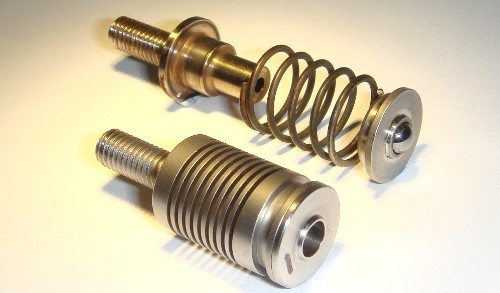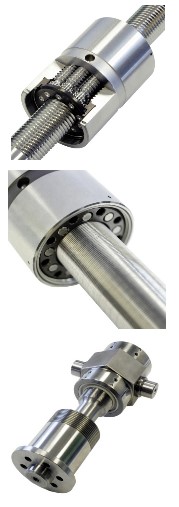Hello Sir/Madam, The ABSSAC Ezine is always kept short and informative, whilst hopefully remaining worthwhile to anyone who is a user or buyer of linear and rotary power transmission equipment. As always, should you wish to no longer receive such updates please just hit the unsubscribe button at the bottom of the page. This newsletter predominantly looks at two product advances we have made. It is not often you come across a product that is breaking the boundaries of design and performance on what is probably one of the oldest energy storing devices known to man. However, the machined spring, justifiably holds that claim. How the machined springs are actually manufactured is a very closely guarded secret but as the name suggests, whether the spring is destined for compression, extension or torsion use, it is literally machined from a solid piece of material. Why machine a spring ? The machined spring provides enhanced performance simply not available from wound spring designs. The most common configuration is the single start spring, which consists of a single continuous coil element, starting at one end and terminating at the other end, much like its wire wound counterpart. However, uniquely we can offer a double start or indeed a triple start spring which has two or three intertwined continuous coil elements, still within the same single part construction. In effect, this puts multiple independent helixes in the same cylindrical plane. Multi-start springs have many advantages. When applied to compression and extension springs, a single start spring provides a reaction force plus a moment. On multiple start flexures, all internal moments are resolved within the spring itself, which translates into excellent compression or extension parallelism. Multiple start spring configurations also significantly unify the lateral bending and lateral translation forces and moments around the springs circumference given a lateral deflection. Double and triple start variants make the loading points irrelevant on the radius of the spring but increase the accuracy of parallelism. Multiple starts as high as five have been employed to unify the lateral reaction forces of machined springs. Machined springs can provide very precise, linear deflection rates because virtually all-residual stresses are eliminated. As a result, there are no internal stresses to overcome before deflection occurs, which again can be the case in the wire wound spring. (Normal rate accuracy is +/-10% but we have obtained +/-0.1% for the more demanding applications) Applications to date have been numerous and in all types of industry. Abssac has recently aided the design and reliability of a compression spring control mechanism that originally involved the amalgamation of four separate parts. Those being a wound compression spring, a machined spring seat, which incorporated a captivated ball bearing and finally a machined top hat attachment complete with a M5 locating thread. An additional issue with the original design was that the customer had to batch test the wound springs before assembly for dimensional accuracy and performance. All of these parts were sourced from separate suppliers and then assembled at the customer’s factory. Utilising the unique properties of the Heli-Cal machined spring, Abssac was able to supply a ready to fit part machined from a single piece of material, that not only incorporated all of these design requirements but also ensured that the actual compression spring rate would be accurately supplied in each part, time and time again,. The new abssac part immediately eliminated this batch control process and as a direct result of the machined springs efficiency of operation there was a marked percentage efficiency increase within the control mechanism. Uniquely, Abssac incorporated a double start machined compression spring set up into the design. The part had to accept a very high temperature of up to 350 C and compress up to 10mm from its free state. For further details on machined springs please call Chris Cattle or follow the web link to our dedicated web page for machined springs
If you are involved with linear applications you might be interested in the Satellite roller screw program. Different to a ball screw, roller screws employ matched rollers to rotate (or satellite as the product name suggests) around the screw during actuation, instead of ball bearings. By the nature of the design there is an immediate increase in the physical amount of contact points on the screw that can support the load compared with that of the same diameter ball screw. The result is that static load can be 3 times greater than that of ball screws and their lifespan is 15 times longer. The many points of contact also give a satellite roller screw greater rigidity and shock tolerance than a ball screw without a compromise to friction or efficiency. Lastly, satellite roller screws can rotate significantly faster and support much greater accelerations than ball screws as there is no recycling of the ball bearings. In fact, a roller screw mechanism can handle twice the rotation speed of a ball screw. It is also possible to supply planetary roller screws with smaller leads compared to ball screws. As the lead is a function of the pitch of the planetary roller screw, the lead can be very small (0.5mm and even less). The lead can be chosen and supplied without any geometrical changes of both the screw shaft and the nut body. In a ball screw the lead is limited by the dimension (Outside Diameter) of the bearing ball, which is a standard feature. The ABSSAC satellite screw product has two standard designs directly aimed at replacing less effective ball screw designs. There is also a full design capability of the standard satellite screw program which continues to “upgrade” linear designs around the world. For further details on satellite roller screw please call Chris Cattle or follow the web link to our dedicated web page for satellite screws
| ||||||||||||||||||||
| ||||||||||||||||||||



